Strategic Recommendations for Ryanair: Suitability, Feasibility
VerifiedAdded on 2023/06/10
|17
|4307
|470
Case Study
AI Summary
This case study provides a comprehensive analysis of Ryanair's strategic management, focusing on its internal environment through VRIO, SWOT, and TOWS analyses. It evaluates Ryanair's resources, capabilities, strengths, weaknesses, opportunities, and threats, and proposes strategic recommendations based on these analyses. The report also suggests the implementation of John P. Kotter's eight-step change management model to facilitate transformational change within the organization. Furthermore, the study assesses the suitability, feasibility, and acceptability of the recommended strategies, offering a holistic view of Ryanair's strategic position and potential future directions within the competitive European budget airlines industry. The goal is to minimize structural costs and gain a competitive edge, taking into account market dynamics such as Brexit, rising oil prices, overcapacity, and high competition.

RUNNING HEAD: Strategic Management
Strategic Management
Strategic Management
Paraphrase This Document
Need a fresh take? Get an instant paraphrase of this document with our AI Paraphraser
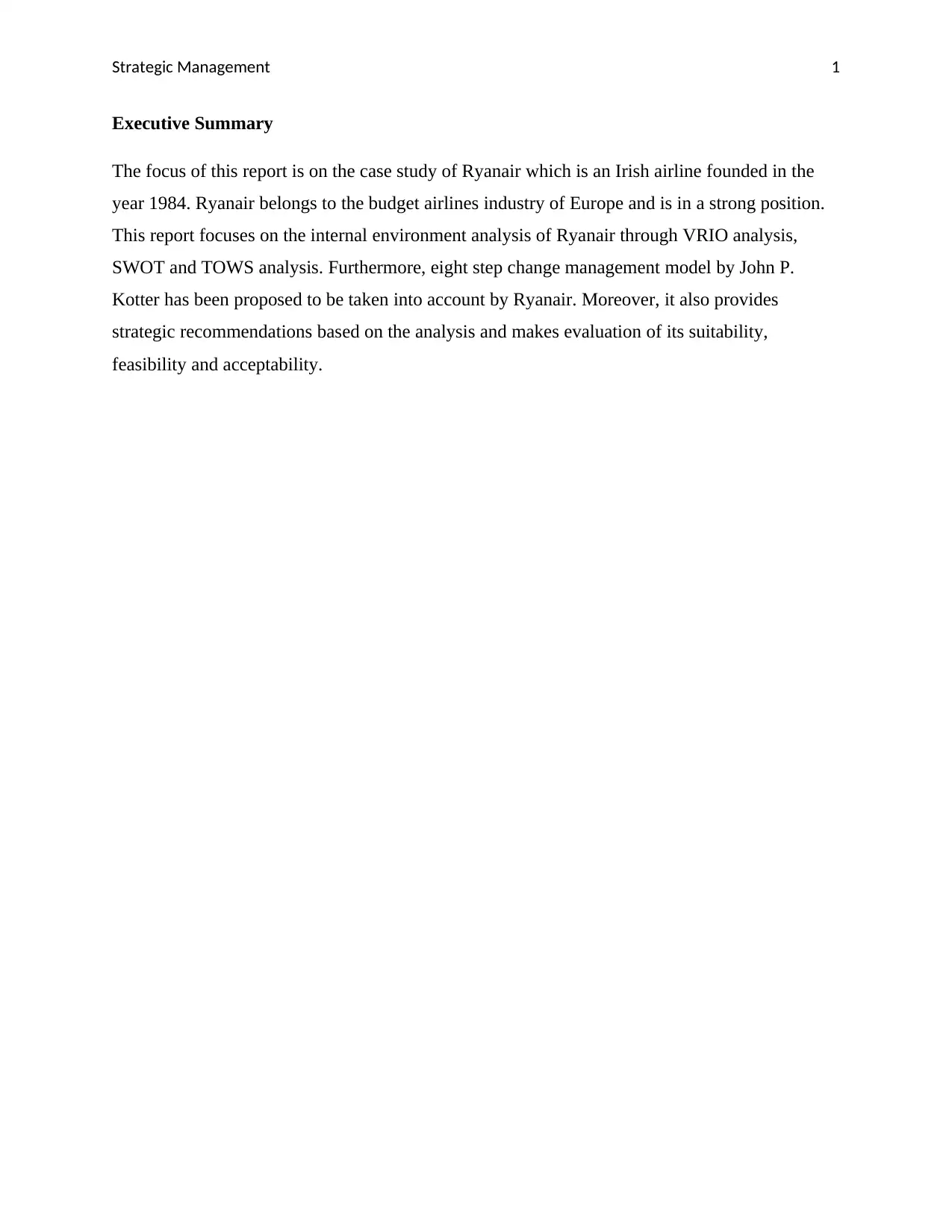
Strategic Management 1
Executive Summary
The focus of this report is on the case study of Ryanair which is an Irish airline founded in the
year 1984. Ryanair belongs to the budget airlines industry of Europe and is in a strong position.
This report focuses on the internal environment analysis of Ryanair through VRIO analysis,
SWOT and TOWS analysis. Furthermore, eight step change management model by John P.
Kotter has been proposed to be taken into account by Ryanair. Moreover, it also provides
strategic recommendations based on the analysis and makes evaluation of its suitability,
feasibility and acceptability.
Executive Summary
The focus of this report is on the case study of Ryanair which is an Irish airline founded in the
year 1984. Ryanair belongs to the budget airlines industry of Europe and is in a strong position.
This report focuses on the internal environment analysis of Ryanair through VRIO analysis,
SWOT and TOWS analysis. Furthermore, eight step change management model by John P.
Kotter has been proposed to be taken into account by Ryanair. Moreover, it also provides
strategic recommendations based on the analysis and makes evaluation of its suitability,
feasibility and acceptability.
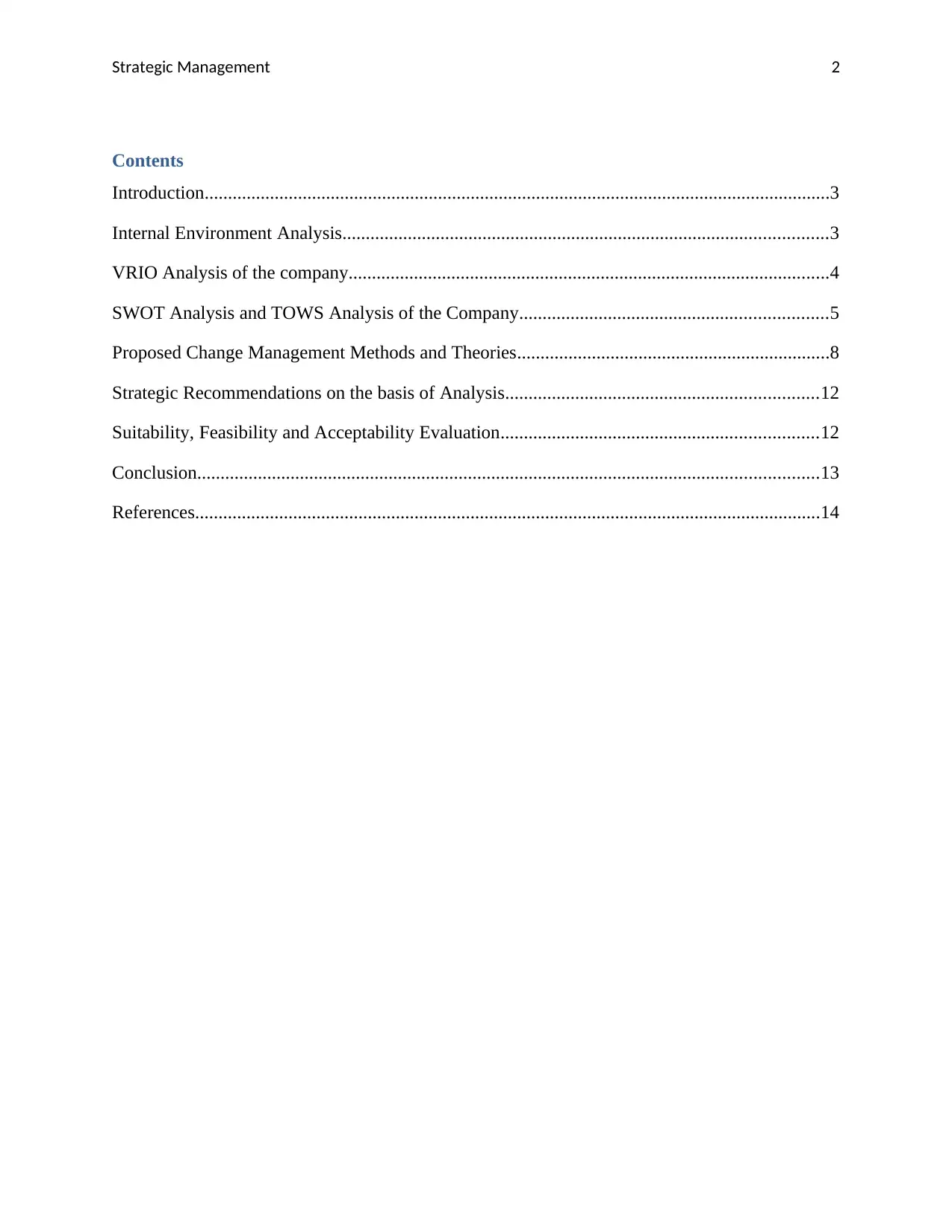
Strategic Management 2
Contents
Introduction......................................................................................................................................3
Internal Environment Analysis........................................................................................................3
VRIO Analysis of the company.......................................................................................................4
SWOT Analysis and TOWS Analysis of the Company..................................................................5
Proposed Change Management Methods and Theories...................................................................8
Strategic Recommendations on the basis of Analysis...................................................................12
Suitability, Feasibility and Acceptability Evaluation....................................................................12
Conclusion.....................................................................................................................................13
References......................................................................................................................................14
Contents
Introduction......................................................................................................................................3
Internal Environment Analysis........................................................................................................3
VRIO Analysis of the company.......................................................................................................4
SWOT Analysis and TOWS Analysis of the Company..................................................................5
Proposed Change Management Methods and Theories...................................................................8
Strategic Recommendations on the basis of Analysis...................................................................12
Suitability, Feasibility and Acceptability Evaluation....................................................................12
Conclusion.....................................................................................................................................13
References......................................................................................................................................14
⊘ This is a preview!⊘
Do you want full access?
Subscribe today to unlock all pages.

Trusted by 1+ million students worldwide
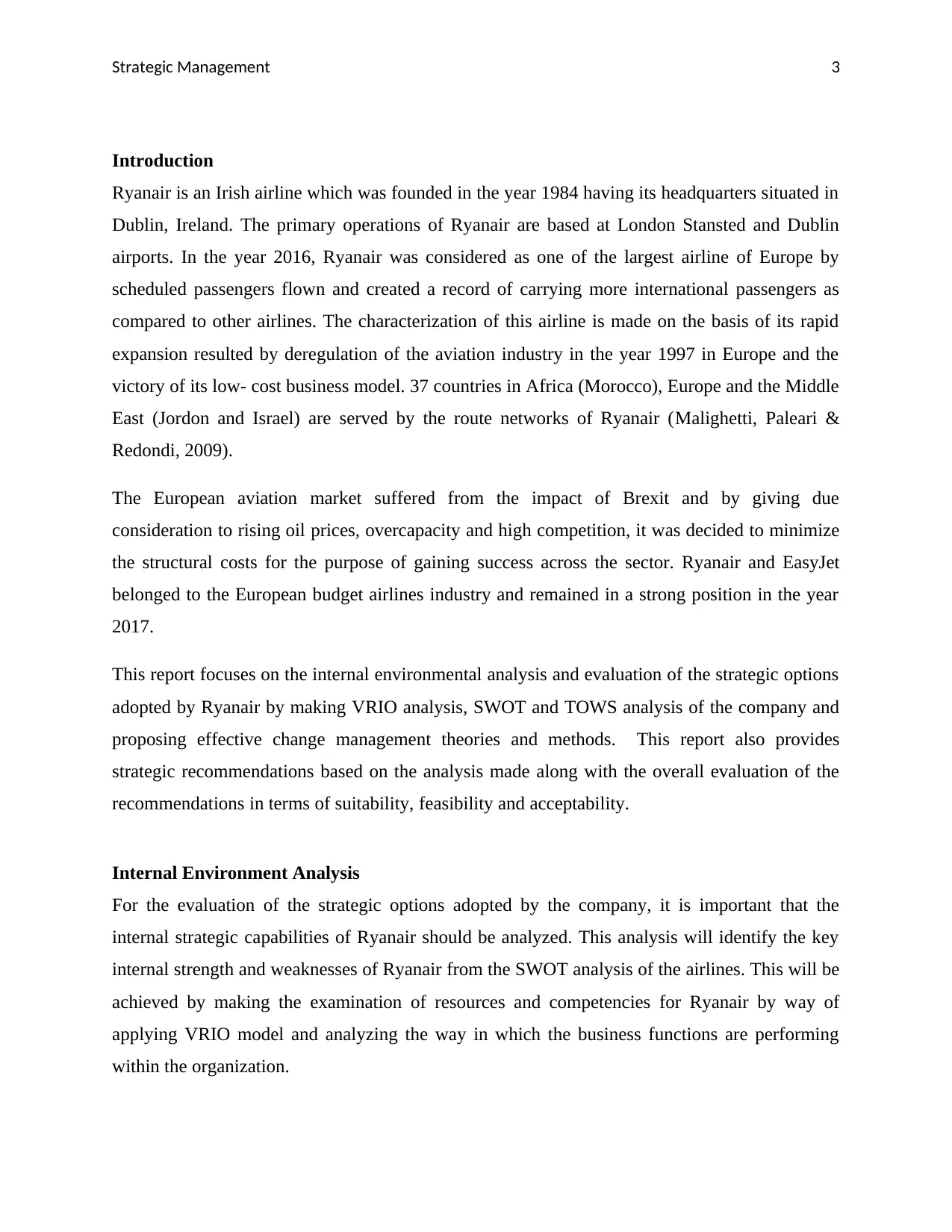
Strategic Management 3
Introduction
Ryanair is an Irish airline which was founded in the year 1984 having its headquarters situated in
Dublin, Ireland. The primary operations of Ryanair are based at London Stansted and Dublin
airports. In the year 2016, Ryanair was considered as one of the largest airline of Europe by
scheduled passengers flown and created a record of carrying more international passengers as
compared to other airlines. The characterization of this airline is made on the basis of its rapid
expansion resulted by deregulation of the aviation industry in the year 1997 in Europe and the
victory of its low- cost business model. 37 countries in Africa (Morocco), Europe and the Middle
East (Jordon and Israel) are served by the route networks of Ryanair (Malighetti, Paleari &
Redondi, 2009).
The European aviation market suffered from the impact of Brexit and by giving due
consideration to rising oil prices, overcapacity and high competition, it was decided to minimize
the structural costs for the purpose of gaining success across the sector. Ryanair and EasyJet
belonged to the European budget airlines industry and remained in a strong position in the year
2017.
This report focuses on the internal environmental analysis and evaluation of the strategic options
adopted by Ryanair by making VRIO analysis, SWOT and TOWS analysis of the company and
proposing effective change management theories and methods. This report also provides
strategic recommendations based on the analysis made along with the overall evaluation of the
recommendations in terms of suitability, feasibility and acceptability.
Internal Environment Analysis
For the evaluation of the strategic options adopted by the company, it is important that the
internal strategic capabilities of Ryanair should be analyzed. This analysis will identify the key
internal strength and weaknesses of Ryanair from the SWOT analysis of the airlines. This will be
achieved by making the examination of resources and competencies for Ryanair by way of
applying VRIO model and analyzing the way in which the business functions are performing
within the organization.
Introduction
Ryanair is an Irish airline which was founded in the year 1984 having its headquarters situated in
Dublin, Ireland. The primary operations of Ryanair are based at London Stansted and Dublin
airports. In the year 2016, Ryanair was considered as one of the largest airline of Europe by
scheduled passengers flown and created a record of carrying more international passengers as
compared to other airlines. The characterization of this airline is made on the basis of its rapid
expansion resulted by deregulation of the aviation industry in the year 1997 in Europe and the
victory of its low- cost business model. 37 countries in Africa (Morocco), Europe and the Middle
East (Jordon and Israel) are served by the route networks of Ryanair (Malighetti, Paleari &
Redondi, 2009).
The European aviation market suffered from the impact of Brexit and by giving due
consideration to rising oil prices, overcapacity and high competition, it was decided to minimize
the structural costs for the purpose of gaining success across the sector. Ryanair and EasyJet
belonged to the European budget airlines industry and remained in a strong position in the year
2017.
This report focuses on the internal environmental analysis and evaluation of the strategic options
adopted by Ryanair by making VRIO analysis, SWOT and TOWS analysis of the company and
proposing effective change management theories and methods. This report also provides
strategic recommendations based on the analysis made along with the overall evaluation of the
recommendations in terms of suitability, feasibility and acceptability.
Internal Environment Analysis
For the evaluation of the strategic options adopted by the company, it is important that the
internal strategic capabilities of Ryanair should be analyzed. This analysis will identify the key
internal strength and weaknesses of Ryanair from the SWOT analysis of the airlines. This will be
achieved by making the examination of resources and competencies for Ryanair by way of
applying VRIO model and analyzing the way in which the business functions are performing
within the organization.
Paraphrase This Document
Need a fresh take? Get an instant paraphrase of this document with our AI Paraphraser
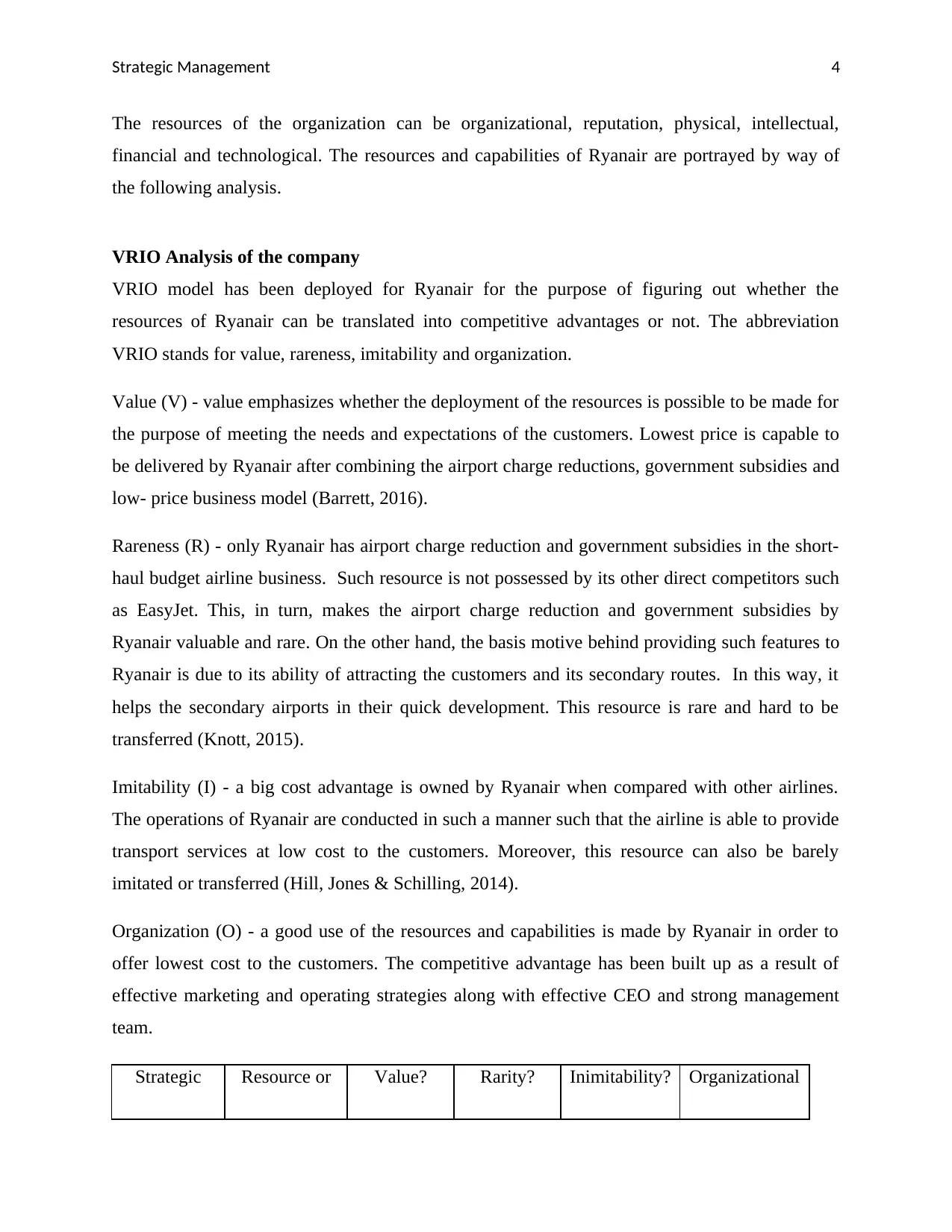
Strategic Management 4
The resources of the organization can be organizational, reputation, physical, intellectual,
financial and technological. The resources and capabilities of Ryanair are portrayed by way of
the following analysis.
VRIO Analysis of the company
VRIO model has been deployed for Ryanair for the purpose of figuring out whether the
resources of Ryanair can be translated into competitive advantages or not. The abbreviation
VRIO stands for value, rareness, imitability and organization.
Value (V) - value emphasizes whether the deployment of the resources is possible to be made for
the purpose of meeting the needs and expectations of the customers. Lowest price is capable to
be delivered by Ryanair after combining the airport charge reductions, government subsidies and
low- price business model (Barrett, 2016).
Rareness (R) - only Ryanair has airport charge reduction and government subsidies in the short-
haul budget airline business. Such resource is not possessed by its other direct competitors such
as EasyJet. This, in turn, makes the airport charge reduction and government subsidies by
Ryanair valuable and rare. On the other hand, the basis motive behind providing such features to
Ryanair is due to its ability of attracting the customers and its secondary routes. In this way, it
helps the secondary airports in their quick development. This resource is rare and hard to be
transferred (Knott, 2015).
Imitability (I) - a big cost advantage is owned by Ryanair when compared with other airlines.
The operations of Ryanair are conducted in such a manner such that the airline is able to provide
transport services at low cost to the customers. Moreover, this resource can also be barely
imitated or transferred (Hill, Jones & Schilling, 2014).
Organization (O) - a good use of the resources and capabilities is made by Ryanair in order to
offer lowest cost to the customers. The competitive advantage has been built up as a result of
effective marketing and operating strategies along with effective CEO and strong management
team.
Strategic Resource or Value? Rarity? Inimitability? Organizational
The resources of the organization can be organizational, reputation, physical, intellectual,
financial and technological. The resources and capabilities of Ryanair are portrayed by way of
the following analysis.
VRIO Analysis of the company
VRIO model has been deployed for Ryanair for the purpose of figuring out whether the
resources of Ryanair can be translated into competitive advantages or not. The abbreviation
VRIO stands for value, rareness, imitability and organization.
Value (V) - value emphasizes whether the deployment of the resources is possible to be made for
the purpose of meeting the needs and expectations of the customers. Lowest price is capable to
be delivered by Ryanair after combining the airport charge reductions, government subsidies and
low- price business model (Barrett, 2016).
Rareness (R) - only Ryanair has airport charge reduction and government subsidies in the short-
haul budget airline business. Such resource is not possessed by its other direct competitors such
as EasyJet. This, in turn, makes the airport charge reduction and government subsidies by
Ryanair valuable and rare. On the other hand, the basis motive behind providing such features to
Ryanair is due to its ability of attracting the customers and its secondary routes. In this way, it
helps the secondary airports in their quick development. This resource is rare and hard to be
transferred (Knott, 2015).
Imitability (I) - a big cost advantage is owned by Ryanair when compared with other airlines.
The operations of Ryanair are conducted in such a manner such that the airline is able to provide
transport services at low cost to the customers. Moreover, this resource can also be barely
imitated or transferred (Hill, Jones & Schilling, 2014).
Organization (O) - a good use of the resources and capabilities is made by Ryanair in order to
offer lowest cost to the customers. The competitive advantage has been built up as a result of
effective marketing and operating strategies along with effective CEO and strong management
team.
Strategic Resource or Value? Rarity? Inimitability? Organizational
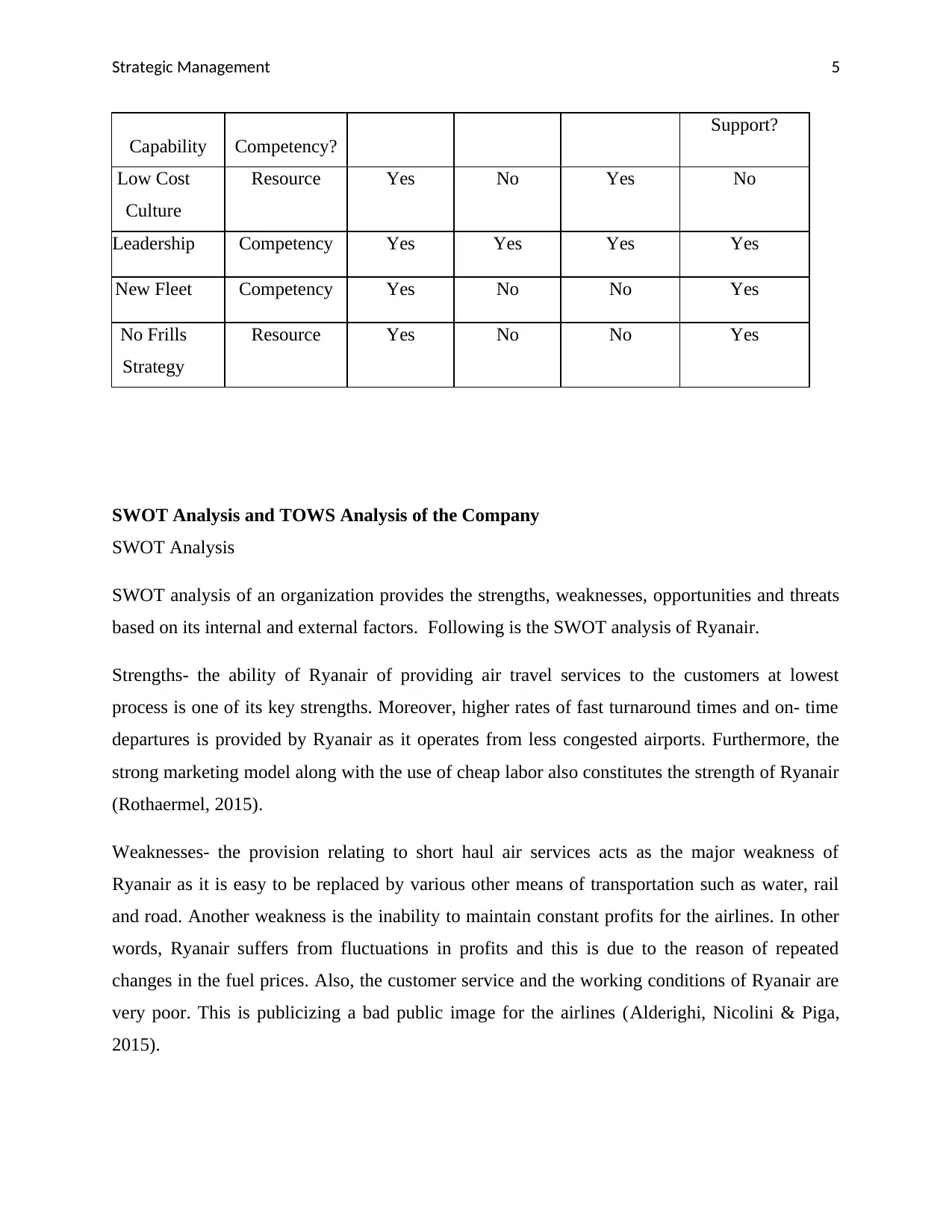
Strategic Management 5
Capability Competency?
Support?
Low Cost
Culture
Resource Yes No Yes No
Leadership Competency Yes Yes Yes Yes
New Fleet Competency Yes No No Yes
No Frills
Strategy
Resource Yes No No Yes
SWOT Analysis and TOWS Analysis of the Company
SWOT Analysis
SWOT analysis of an organization provides the strengths, weaknesses, opportunities and threats
based on its internal and external factors. Following is the SWOT analysis of Ryanair.
Strengths- the ability of Ryanair of providing air travel services to the customers at lowest
process is one of its key strengths. Moreover, higher rates of fast turnaround times and on- time
departures is provided by Ryanair as it operates from less congested airports. Furthermore, the
strong marketing model along with the use of cheap labor also constitutes the strength of Ryanair
(Rothaermel, 2015).
Weaknesses- the provision relating to short haul air services acts as the major weakness of
Ryanair as it is easy to be replaced by various other means of transportation such as water, rail
and road. Another weakness is the inability to maintain constant profits for the airlines. In other
words, Ryanair suffers from fluctuations in profits and this is due to the reason of repeated
changes in the fuel prices. Also, the customer service and the working conditions of Ryanair are
very poor. This is publicizing a bad public image for the airlines (Alderighi, Nicolini & Piga,
2015).
Capability Competency?
Support?
Low Cost
Culture
Resource Yes No Yes No
Leadership Competency Yes Yes Yes Yes
New Fleet Competency Yes No No Yes
No Frills
Strategy
Resource Yes No No Yes
SWOT Analysis and TOWS Analysis of the Company
SWOT Analysis
SWOT analysis of an organization provides the strengths, weaknesses, opportunities and threats
based on its internal and external factors. Following is the SWOT analysis of Ryanair.
Strengths- the ability of Ryanair of providing air travel services to the customers at lowest
process is one of its key strengths. Moreover, higher rates of fast turnaround times and on- time
departures is provided by Ryanair as it operates from less congested airports. Furthermore, the
strong marketing model along with the use of cheap labor also constitutes the strength of Ryanair
(Rothaermel, 2015).
Weaknesses- the provision relating to short haul air services acts as the major weakness of
Ryanair as it is easy to be replaced by various other means of transportation such as water, rail
and road. Another weakness is the inability to maintain constant profits for the airlines. In other
words, Ryanair suffers from fluctuations in profits and this is due to the reason of repeated
changes in the fuel prices. Also, the customer service and the working conditions of Ryanair are
very poor. This is publicizing a bad public image for the airlines (Alderighi, Nicolini & Piga,
2015).
⊘ This is a preview!⊘
Do you want full access?
Subscribe today to unlock all pages.

Trusted by 1+ million students worldwide
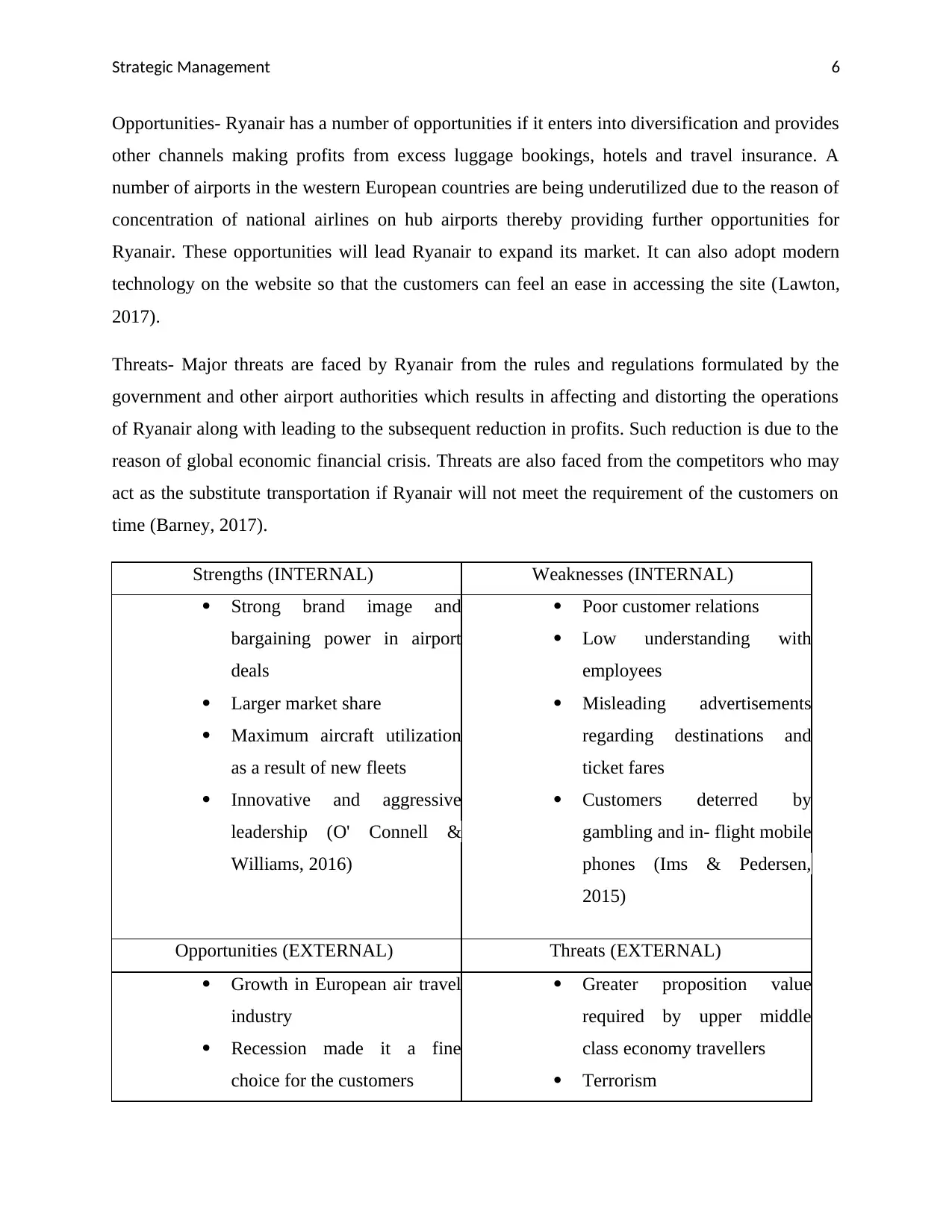
Strategic Management 6
Opportunities- Ryanair has a number of opportunities if it enters into diversification and provides
other channels making profits from excess luggage bookings, hotels and travel insurance. A
number of airports in the western European countries are being underutilized due to the reason of
concentration of national airlines on hub airports thereby providing further opportunities for
Ryanair. These opportunities will lead Ryanair to expand its market. It can also adopt modern
technology on the website so that the customers can feel an ease in accessing the site (Lawton,
2017).
Threats- Major threats are faced by Ryanair from the rules and regulations formulated by the
government and other airport authorities which results in affecting and distorting the operations
of Ryanair along with leading to the subsequent reduction in profits. Such reduction is due to the
reason of global economic financial crisis. Threats are also faced from the competitors who may
act as the substitute transportation if Ryanair will not meet the requirement of the customers on
time (Barney, 2017).
Strengths (INTERNAL) Weaknesses (INTERNAL)
Strong brand image and
bargaining power in airport
deals
Larger market share
Maximum aircraft utilization
as a result of new fleets
Innovative and aggressive
leadership (O' Connell &
Williams, 2016)
Poor customer relations
Low understanding with
employees
Misleading advertisements
regarding destinations and
ticket fares
Customers deterred by
gambling and in- flight mobile
phones (Ims & Pedersen,
2015)
Opportunities (EXTERNAL) Threats (EXTERNAL)
Growth in European air travel
industry
Recession made it a fine
choice for the customers
Greater proposition value
required by upper middle
class economy travellers
Terrorism
Opportunities- Ryanair has a number of opportunities if it enters into diversification and provides
other channels making profits from excess luggage bookings, hotels and travel insurance. A
number of airports in the western European countries are being underutilized due to the reason of
concentration of national airlines on hub airports thereby providing further opportunities for
Ryanair. These opportunities will lead Ryanair to expand its market. It can also adopt modern
technology on the website so that the customers can feel an ease in accessing the site (Lawton,
2017).
Threats- Major threats are faced by Ryanair from the rules and regulations formulated by the
government and other airport authorities which results in affecting and distorting the operations
of Ryanair along with leading to the subsequent reduction in profits. Such reduction is due to the
reason of global economic financial crisis. Threats are also faced from the competitors who may
act as the substitute transportation if Ryanair will not meet the requirement of the customers on
time (Barney, 2017).
Strengths (INTERNAL) Weaknesses (INTERNAL)
Strong brand image and
bargaining power in airport
deals
Larger market share
Maximum aircraft utilization
as a result of new fleets
Innovative and aggressive
leadership (O' Connell &
Williams, 2016)
Poor customer relations
Low understanding with
employees
Misleading advertisements
regarding destinations and
ticket fares
Customers deterred by
gambling and in- flight mobile
phones (Ims & Pedersen,
2015)
Opportunities (EXTERNAL) Threats (EXTERNAL)
Growth in European air travel
industry
Recession made it a fine
choice for the customers
Greater proposition value
required by upper middle
class economy travellers
Terrorism
Paraphrase This Document
Need a fresh take? Get an instant paraphrase of this document with our AI Paraphraser
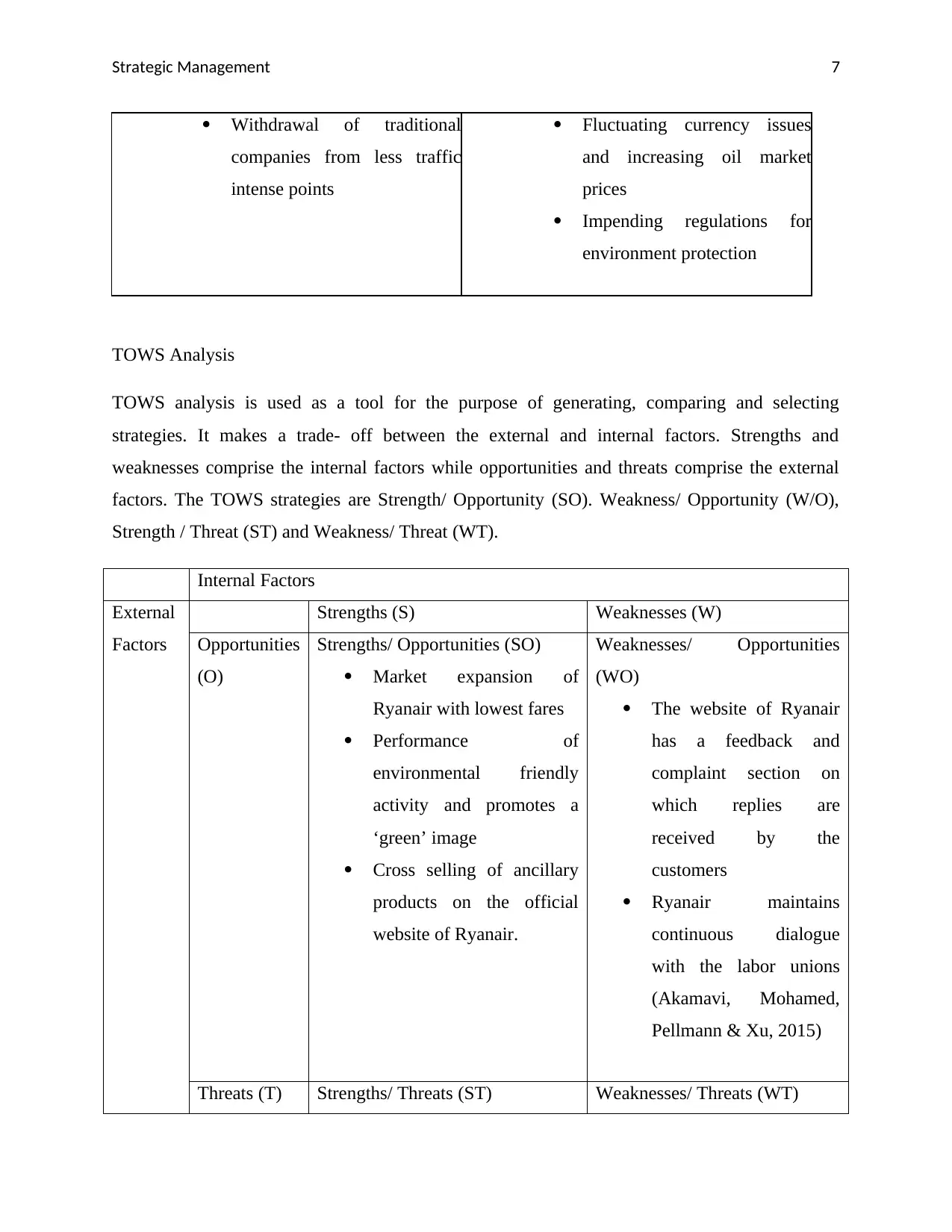
Strategic Management 7
Withdrawal of traditional
companies from less traffic
intense points
Fluctuating currency issues
and increasing oil market
prices
Impending regulations for
environment protection
TOWS Analysis
TOWS analysis is used as a tool for the purpose of generating, comparing and selecting
strategies. It makes a trade- off between the external and internal factors. Strengths and
weaknesses comprise the internal factors while opportunities and threats comprise the external
factors. The TOWS strategies are Strength/ Opportunity (SO). Weakness/ Opportunity (W/O),
Strength / Threat (ST) and Weakness/ Threat (WT).
Internal Factors
External
Factors
Strengths (S) Weaknesses (W)
Opportunities
(O)
Strengths/ Opportunities (SO)
Market expansion of
Ryanair with lowest fares
Performance of
environmental friendly
activity and promotes a
‘green’ image
Cross selling of ancillary
products on the official
website of Ryanair.
Weaknesses/ Opportunities
(WO)
The website of Ryanair
has a feedback and
complaint section on
which replies are
received by the
customers
Ryanair maintains
continuous dialogue
with the labor unions
(Akamavi, Mohamed,
Pellmann & Xu, 2015)
Threats (T) Strengths/ Threats (ST) Weaknesses/ Threats (WT)
Withdrawal of traditional
companies from less traffic
intense points
Fluctuating currency issues
and increasing oil market
prices
Impending regulations for
environment protection
TOWS Analysis
TOWS analysis is used as a tool for the purpose of generating, comparing and selecting
strategies. It makes a trade- off between the external and internal factors. Strengths and
weaknesses comprise the internal factors while opportunities and threats comprise the external
factors. The TOWS strategies are Strength/ Opportunity (SO). Weakness/ Opportunity (W/O),
Strength / Threat (ST) and Weakness/ Threat (WT).
Internal Factors
External
Factors
Strengths (S) Weaknesses (W)
Opportunities
(O)
Strengths/ Opportunities (SO)
Market expansion of
Ryanair with lowest fares
Performance of
environmental friendly
activity and promotes a
‘green’ image
Cross selling of ancillary
products on the official
website of Ryanair.
Weaknesses/ Opportunities
(WO)
The website of Ryanair
has a feedback and
complaint section on
which replies are
received by the
customers
Ryanair maintains
continuous dialogue
with the labor unions
(Akamavi, Mohamed,
Pellmann & Xu, 2015)
Threats (T) Strengths/ Threats (ST) Weaknesses/ Threats (WT)
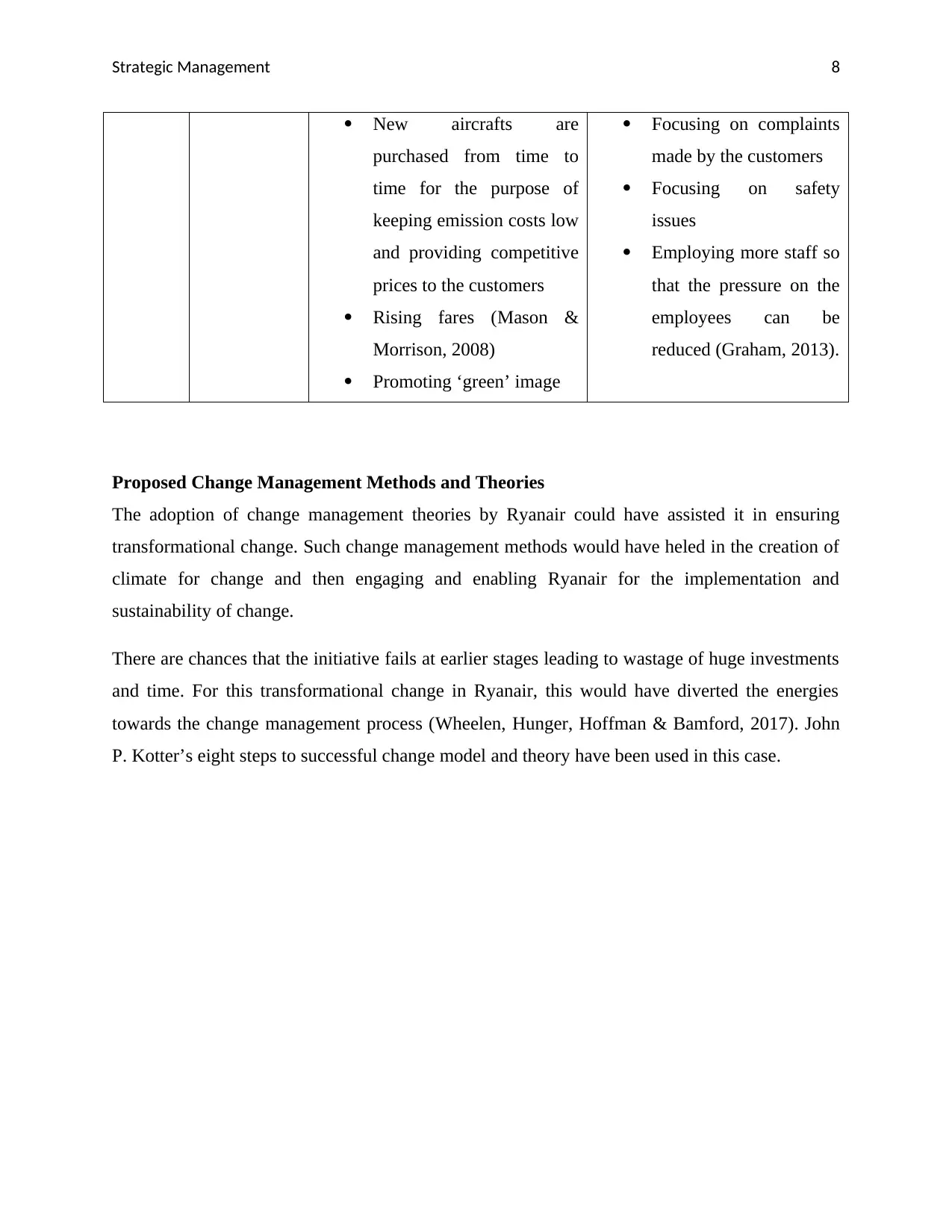
Strategic Management 8
New aircrafts are
purchased from time to
time for the purpose of
keeping emission costs low
and providing competitive
prices to the customers
Rising fares (Mason &
Morrison, 2008)
Promoting ‘green’ image
Focusing on complaints
made by the customers
Focusing on safety
issues
Employing more staff so
that the pressure on the
employees can be
reduced (Graham, 2013).
Proposed Change Management Methods and Theories
The adoption of change management theories by Ryanair could have assisted it in ensuring
transformational change. Such change management methods would have heled in the creation of
climate for change and then engaging and enabling Ryanair for the implementation and
sustainability of change.
There are chances that the initiative fails at earlier stages leading to wastage of huge investments
and time. For this transformational change in Ryanair, this would have diverted the energies
towards the change management process (Wheelen, Hunger, Hoffman & Bamford, 2017). John
P. Kotter’s eight steps to successful change model and theory have been used in this case.
New aircrafts are
purchased from time to
time for the purpose of
keeping emission costs low
and providing competitive
prices to the customers
Rising fares (Mason &
Morrison, 2008)
Promoting ‘green’ image
Focusing on complaints
made by the customers
Focusing on safety
issues
Employing more staff so
that the pressure on the
employees can be
reduced (Graham, 2013).
Proposed Change Management Methods and Theories
The adoption of change management theories by Ryanair could have assisted it in ensuring
transformational change. Such change management methods would have heled in the creation of
climate for change and then engaging and enabling Ryanair for the implementation and
sustainability of change.
There are chances that the initiative fails at earlier stages leading to wastage of huge investments
and time. For this transformational change in Ryanair, this would have diverted the energies
towards the change management process (Wheelen, Hunger, Hoffman & Bamford, 2017). John
P. Kotter’s eight steps to successful change model and theory have been used in this case.
⊘ This is a preview!⊘
Do you want full access?
Subscribe today to unlock all pages.

Trusted by 1+ million students worldwide
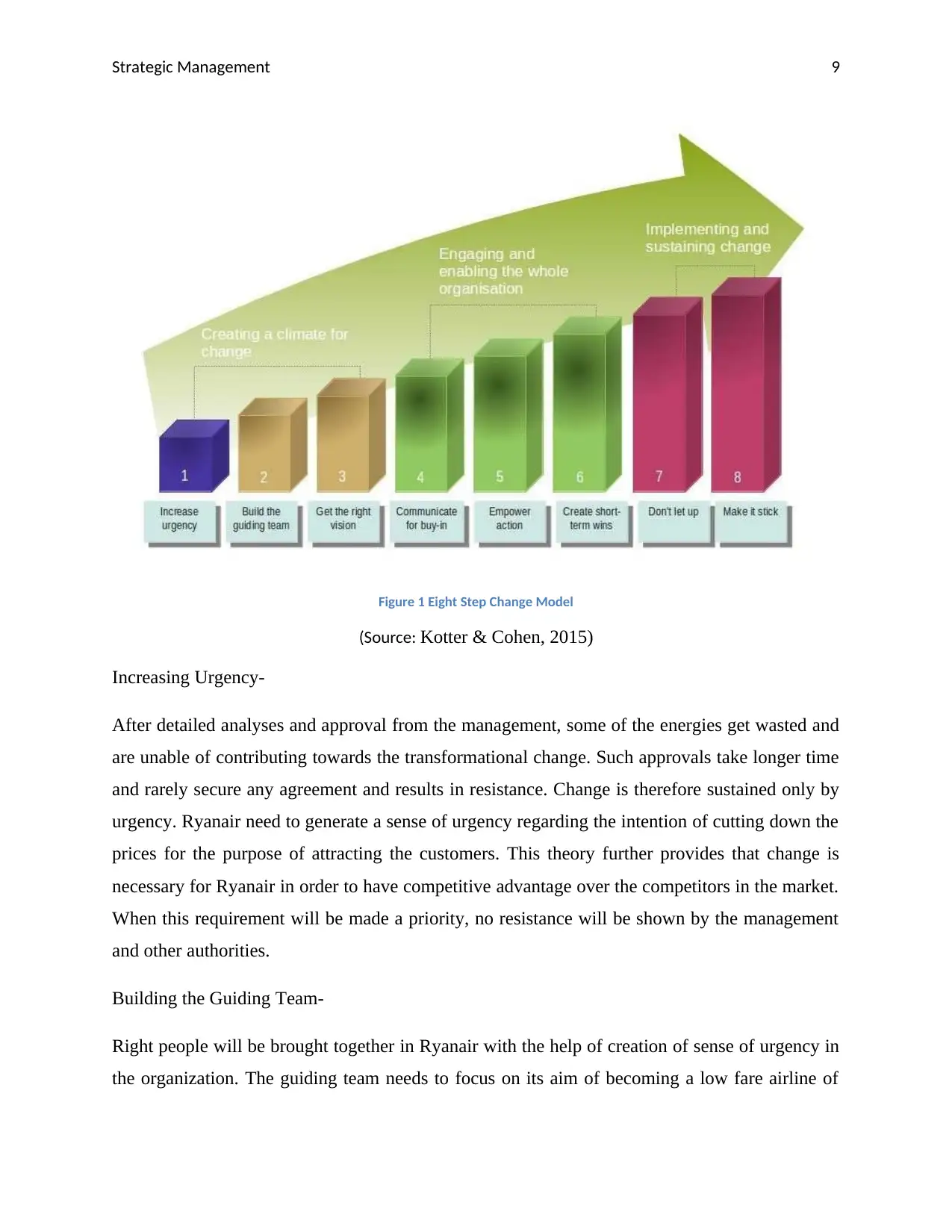
Strategic Management 9
Figure 1 Eight Step Change Model
(Source: Kotter & Cohen, 2015)
Increasing Urgency-
After detailed analyses and approval from the management, some of the energies get wasted and
are unable of contributing towards the transformational change. Such approvals take longer time
and rarely secure any agreement and results in resistance. Change is therefore sustained only by
urgency. Ryanair need to generate a sense of urgency regarding the intention of cutting down the
prices for the purpose of attracting the customers. This theory further provides that change is
necessary for Ryanair in order to have competitive advantage over the competitors in the market.
When this requirement will be made a priority, no resistance will be shown by the management
and other authorities.
Building the Guiding Team-
Right people will be brought together in Ryanair with the help of creation of sense of urgency in
the organization. The guiding team needs to focus on its aim of becoming a low fare airline of
Figure 1 Eight Step Change Model
(Source: Kotter & Cohen, 2015)
Increasing Urgency-
After detailed analyses and approval from the management, some of the energies get wasted and
are unable of contributing towards the transformational change. Such approvals take longer time
and rarely secure any agreement and results in resistance. Change is therefore sustained only by
urgency. Ryanair need to generate a sense of urgency regarding the intention of cutting down the
prices for the purpose of attracting the customers. This theory further provides that change is
necessary for Ryanair in order to have competitive advantage over the competitors in the market.
When this requirement will be made a priority, no resistance will be shown by the management
and other authorities.
Building the Guiding Team-
Right people will be brought together in Ryanair with the help of creation of sense of urgency in
the organization. The guiding team needs to focus on its aim of becoming a low fare airline of
Paraphrase This Document
Need a fresh take? Get an instant paraphrase of this document with our AI Paraphraser
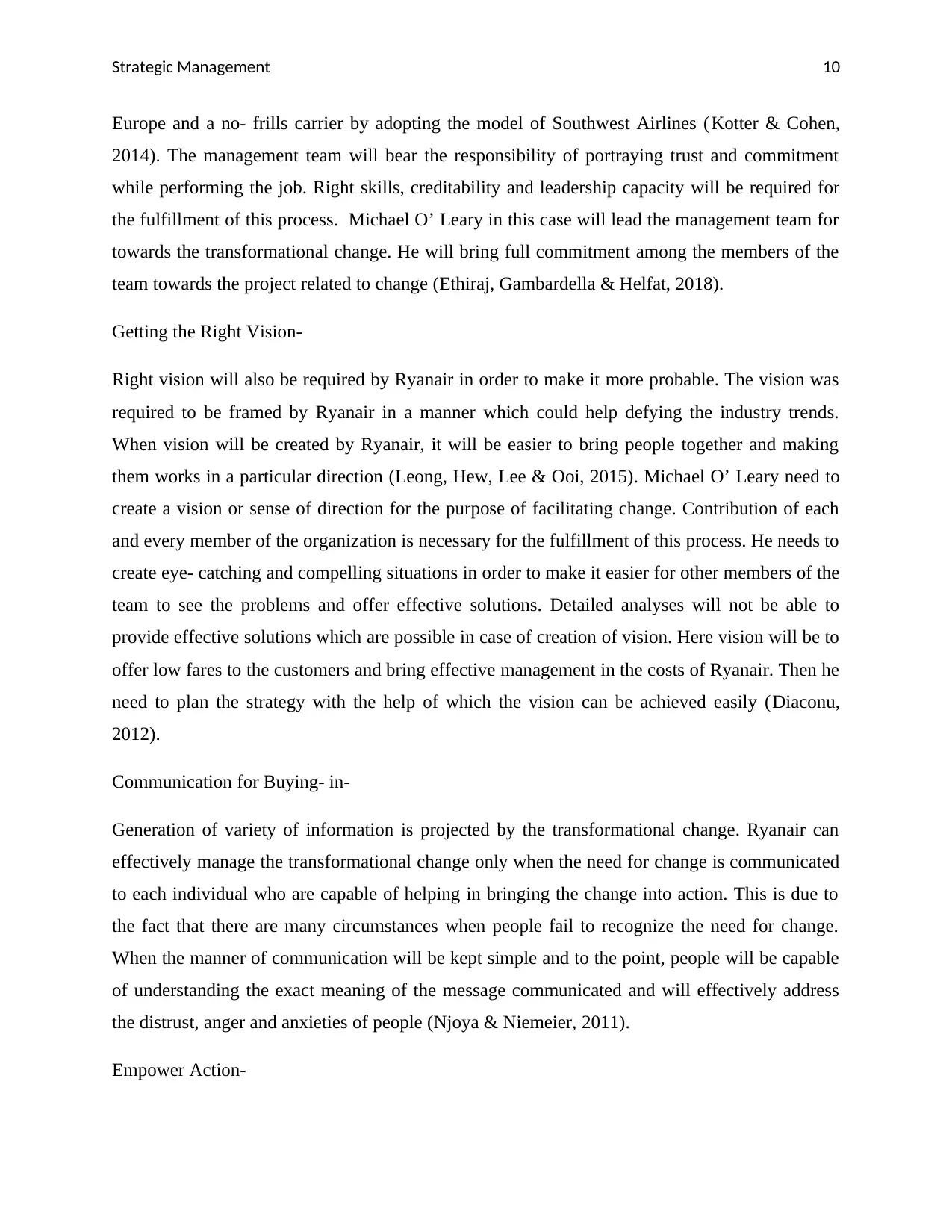
Strategic Management 10
Europe and a no- frills carrier by adopting the model of Southwest Airlines (Kotter & Cohen,
2014). The management team will bear the responsibility of portraying trust and commitment
while performing the job. Right skills, creditability and leadership capacity will be required for
the fulfillment of this process. Michael O’ Leary in this case will lead the management team for
towards the transformational change. He will bring full commitment among the members of the
team towards the project related to change (Ethiraj, Gambardella & Helfat, 2018).
Getting the Right Vision-
Right vision will also be required by Ryanair in order to make it more probable. The vision was
required to be framed by Ryanair in a manner which could help defying the industry trends.
When vision will be created by Ryanair, it will be easier to bring people together and making
them works in a particular direction (Leong, Hew, Lee & Ooi, 2015). Michael O’ Leary need to
create a vision or sense of direction for the purpose of facilitating change. Contribution of each
and every member of the organization is necessary for the fulfillment of this process. He needs to
create eye- catching and compelling situations in order to make it easier for other members of the
team to see the problems and offer effective solutions. Detailed analyses will not be able to
provide effective solutions which are possible in case of creation of vision. Here vision will be to
offer low fares to the customers and bring effective management in the costs of Ryanair. Then he
need to plan the strategy with the help of which the vision can be achieved easily (Diaconu,
2012).
Communication for Buying- in-
Generation of variety of information is projected by the transformational change. Ryanair can
effectively manage the transformational change only when the need for change is communicated
to each individual who are capable of helping in bringing the change into action. This is due to
the fact that there are many circumstances when people fail to recognize the need for change.
When the manner of communication will be kept simple and to the point, people will be capable
of understanding the exact meaning of the message communicated and will effectively address
the distrust, anger and anxieties of people (Njoya & Niemeier, 2011).
Empower Action-
Europe and a no- frills carrier by adopting the model of Southwest Airlines (Kotter & Cohen,
2014). The management team will bear the responsibility of portraying trust and commitment
while performing the job. Right skills, creditability and leadership capacity will be required for
the fulfillment of this process. Michael O’ Leary in this case will lead the management team for
towards the transformational change. He will bring full commitment among the members of the
team towards the project related to change (Ethiraj, Gambardella & Helfat, 2018).
Getting the Right Vision-
Right vision will also be required by Ryanair in order to make it more probable. The vision was
required to be framed by Ryanair in a manner which could help defying the industry trends.
When vision will be created by Ryanair, it will be easier to bring people together and making
them works in a particular direction (Leong, Hew, Lee & Ooi, 2015). Michael O’ Leary need to
create a vision or sense of direction for the purpose of facilitating change. Contribution of each
and every member of the organization is necessary for the fulfillment of this process. He needs to
create eye- catching and compelling situations in order to make it easier for other members of the
team to see the problems and offer effective solutions. Detailed analyses will not be able to
provide effective solutions which are possible in case of creation of vision. Here vision will be to
offer low fares to the customers and bring effective management in the costs of Ryanair. Then he
need to plan the strategy with the help of which the vision can be achieved easily (Diaconu,
2012).
Communication for Buying- in-
Generation of variety of information is projected by the transformational change. Ryanair can
effectively manage the transformational change only when the need for change is communicated
to each individual who are capable of helping in bringing the change into action. This is due to
the fact that there are many circumstances when people fail to recognize the need for change.
When the manner of communication will be kept simple and to the point, people will be capable
of understanding the exact meaning of the message communicated and will effectively address
the distrust, anger and anxieties of people (Njoya & Niemeier, 2011).
Empower Action-
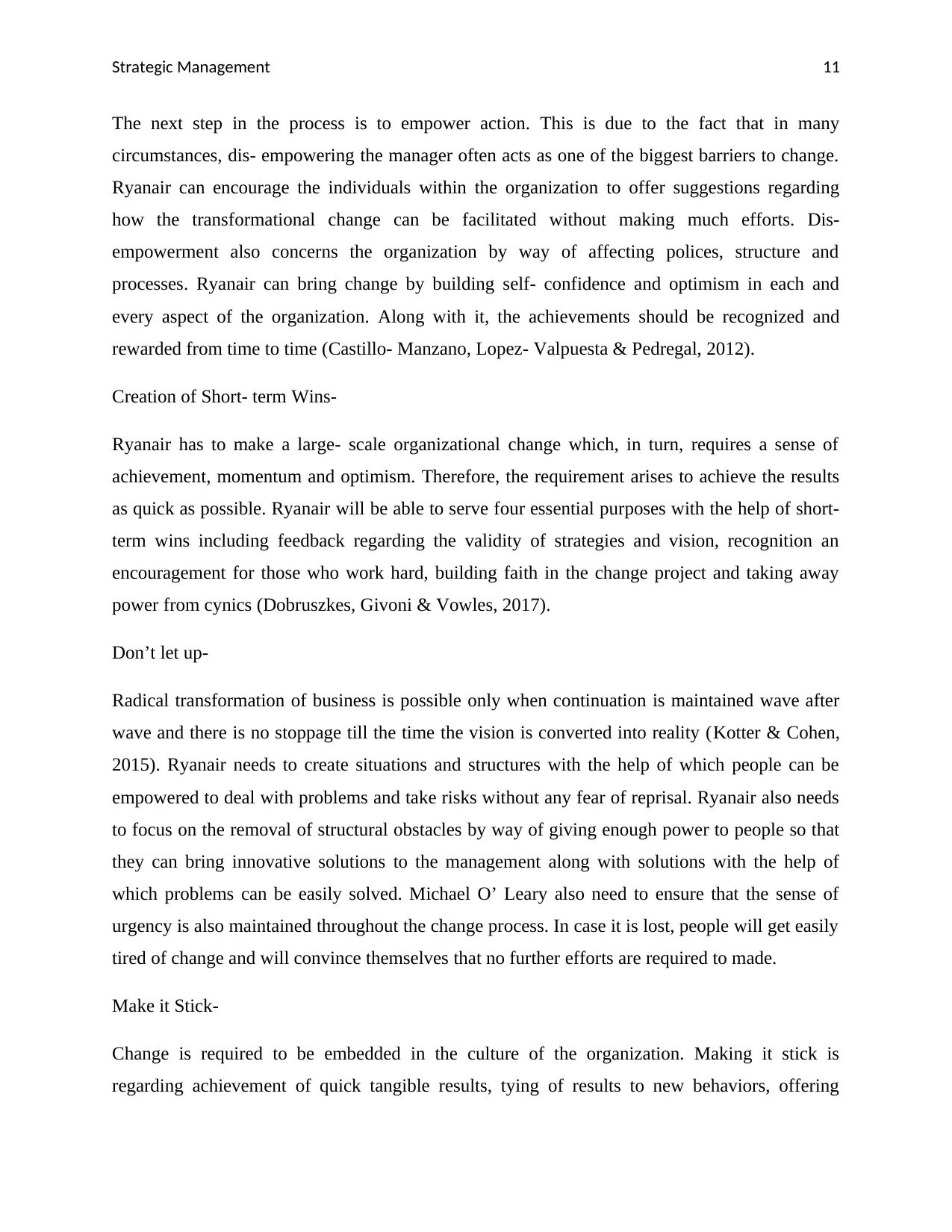
Strategic Management 11
The next step in the process is to empower action. This is due to the fact that in many
circumstances, dis- empowering the manager often acts as one of the biggest barriers to change.
Ryanair can encourage the individuals within the organization to offer suggestions regarding
how the transformational change can be facilitated without making much efforts. Dis-
empowerment also concerns the organization by way of affecting polices, structure and
processes. Ryanair can bring change by building self- confidence and optimism in each and
every aspect of the organization. Along with it, the achievements should be recognized and
rewarded from time to time (Castillo- Manzano, Lopez- Valpuesta & Pedregal, 2012).
Creation of Short- term Wins-
Ryanair has to make a large- scale organizational change which, in turn, requires a sense of
achievement, momentum and optimism. Therefore, the requirement arises to achieve the results
as quick as possible. Ryanair will be able to serve four essential purposes with the help of short-
term wins including feedback regarding the validity of strategies and vision, recognition an
encouragement for those who work hard, building faith in the change project and taking away
power from cynics (Dobruszkes, Givoni & Vowles, 2017).
Don’t let up-
Radical transformation of business is possible only when continuation is maintained wave after
wave and there is no stoppage till the time the vision is converted into reality (Kotter & Cohen,
2015). Ryanair needs to create situations and structures with the help of which people can be
empowered to deal with problems and take risks without any fear of reprisal. Ryanair also needs
to focus on the removal of structural obstacles by way of giving enough power to people so that
they can bring innovative solutions to the management along with solutions with the help of
which problems can be easily solved. Michael O’ Leary also need to ensure that the sense of
urgency is also maintained throughout the change process. In case it is lost, people will get easily
tired of change and will convince themselves that no further efforts are required to made.
Make it Stick-
Change is required to be embedded in the culture of the organization. Making it stick is
regarding achievement of quick tangible results, tying of results to new behaviors, offering
The next step in the process is to empower action. This is due to the fact that in many
circumstances, dis- empowering the manager often acts as one of the biggest barriers to change.
Ryanair can encourage the individuals within the organization to offer suggestions regarding
how the transformational change can be facilitated without making much efforts. Dis-
empowerment also concerns the organization by way of affecting polices, structure and
processes. Ryanair can bring change by building self- confidence and optimism in each and
every aspect of the organization. Along with it, the achievements should be recognized and
rewarded from time to time (Castillo- Manzano, Lopez- Valpuesta & Pedregal, 2012).
Creation of Short- term Wins-
Ryanair has to make a large- scale organizational change which, in turn, requires a sense of
achievement, momentum and optimism. Therefore, the requirement arises to achieve the results
as quick as possible. Ryanair will be able to serve four essential purposes with the help of short-
term wins including feedback regarding the validity of strategies and vision, recognition an
encouragement for those who work hard, building faith in the change project and taking away
power from cynics (Dobruszkes, Givoni & Vowles, 2017).
Don’t let up-
Radical transformation of business is possible only when continuation is maintained wave after
wave and there is no stoppage till the time the vision is converted into reality (Kotter & Cohen,
2015). Ryanair needs to create situations and structures with the help of which people can be
empowered to deal with problems and take risks without any fear of reprisal. Ryanair also needs
to focus on the removal of structural obstacles by way of giving enough power to people so that
they can bring innovative solutions to the management along with solutions with the help of
which problems can be easily solved. Michael O’ Leary also need to ensure that the sense of
urgency is also maintained throughout the change process. In case it is lost, people will get easily
tired of change and will convince themselves that no further efforts are required to made.
Make it Stick-
Change is required to be embedded in the culture of the organization. Making it stick is
regarding achievement of quick tangible results, tying of results to new behaviors, offering
⊘ This is a preview!⊘
Do you want full access?
Subscribe today to unlock all pages.

Trusted by 1+ million students worldwide
1 out of 17
Related Documents
Your All-in-One AI-Powered Toolkit for Academic Success.
+13062052269
info@desklib.com
Available 24*7 on WhatsApp / Email
![[object Object]](/_next/static/media/star-bottom.7253800d.svg)
Unlock your academic potential
Copyright © 2020–2025 A2Z Services. All Rights Reserved. Developed and managed by ZUCOL.




